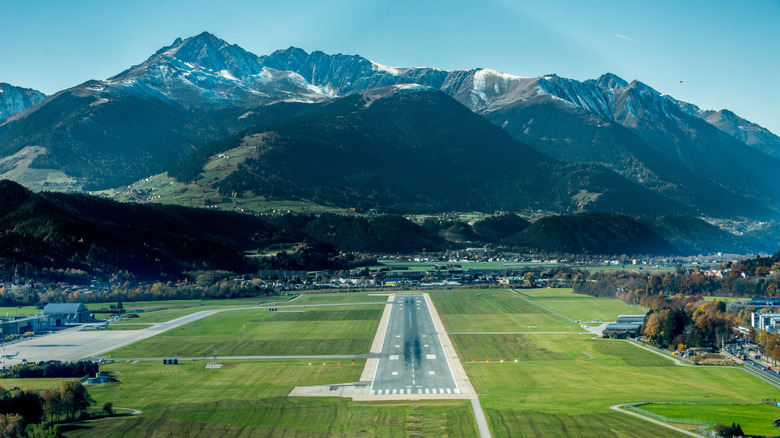Pilots Have No Kind Words For This One Daunting Airport In Europe
If you've ever experienced turbulence during your flight, you may have been nervous or even outright scared. But turbulence on planes is common (and even more so these days because of climate change). However, some airports are particularly known for having unpleasantly turbulent conditions. An EasyJet pilot named Chris, who was interviewed by The Independent, revealed his pick for the most turbulent airport to fly into — Innsbruck Airport in Austria.
Innsbruck is a top destination for skiers and fans of other winter sports, but this airport has gotten a reputation for its challenging flight conditions. "The strong winds in the area can reach speeds of up to 60 mph," Chris told the outlet. "Innsbruck Airport is also infamous for severe turbulence, caused by strong winds funneling through the narrow valleys between the towering mountains that surround it."
The time of year can also make a difference in how turbulent the journey is, with Chris saying the months from November to March will be the bumpiest because the weather is stormier. The stormy season combined with the mountainous terrain can mean a turbulent flight into any of the airports in the Alps, according to Chris. Since January is arguably the best time of year for avid skiers to visit Austria, travelers should prepare themselves ahead of time for a less-than-smooth journey closer to their final destination.
How to prepare for and handle turbulence
While turbulence is less of a big deal than it feels like, it can still be unnerving to even the most seasoned flyers. So knowing what to do during turbulent parts of your flight can help ease worries and keep you safe. Remember to stay calm and follow the instructions and guidance of the flight crew. They are trained for these situations and will prioritize everyone's safety. You'll likely see the seatbelt light go on before you feel any bumps, but it's good practice to always have your seatbelt fastened when you are in your seat. Many injuries related to turbulence have been when passengers weren't buckled up.
Choosing a good seat can also mean a smoother ride. Generally, flyers sitting toward the rear of the plane will have a bumpier experience during turbulence. For nervous flyers, it's recommended to choose seats over the wings, as this area will be the most stable during turbulent scenarios. If those seats are taken, sitting closer to the front of the plane is a good alternative. Travelers can also check the turbulence forecast before a flight to get a better idea of what to expect during their trip.
Turbulence can be scary, but it's completely normal. Keep in mind that the likelihood of being seriously injured because of turbulence is very low. If you're an anxious flyer, check out our best tips for coping with turbulence and consult with a medical professional if necessary.

